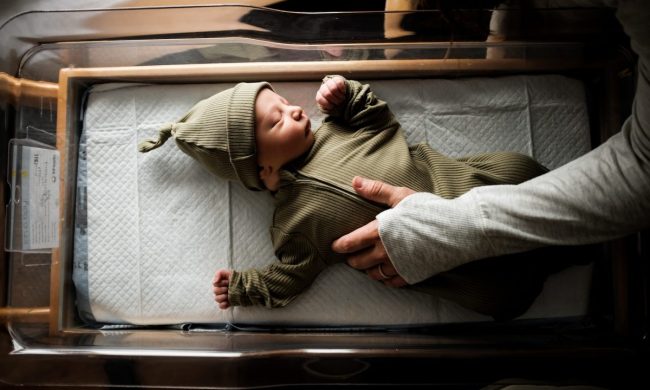The best sound to parents is the sound of a sleeping baby. But how the baby is put to sleep makes a huge difference in the quality of their sleep. While nothing is cuter than a baby sleeping cuddled with their favorite stuffed animal or blanket, is it safe for a baby to sleep on their side?
It doesn’t matter if you are a new parent or an old pro. Every baby is different and does their own thing. So, if you have a baby that likes to sleep on their side, should you let them? Let’s see what the experts say about side sleeping.

Is it safe for babies to sleep on their side?
- If they are at least 4 months old
- Can roll from back to front and front to back
The majority of babies become rolling ninjas between 4 to 6 months old. Once your little one can roll both ways, from front to back and back to front, then you don’t have to worry so much.
The American Academy of Pediatrics recommends that “if the infant call roll from supine (back) to prone (side) and from prone to supine, the infant can then be allowed to remain in the sleep position that he or she assumes.” So once that baby has the roll down both ways, they can decide how they sleep.
But the AAP also states that “All infants continue to be placed supine until 1 year of age.” So always place the baby on their back every single time they go down to sleep, whether it be for the night or a nap. But if you wake up and go check on them and see them on their side – don’t freak out.
What if the baby coughs in their sleep?
Parents freak out about any noise the baby makes. It happens to all of us. A new cough or one too many sneezes, and we freeze with terror and watch the baby like a hawk. A cough in the night will wake a parent up from a dead sleep.
So wouldn’t sleeping on their side be better for a baby in case they cough? No. The AAP says that “multiple studies… have not shown an increased incidence of aspiration.” The National Institutes of Health back this up, saying, “studies show no increase in the number of deaths from choking among babies who sleep on their backs.”

Why a baby shouldn’t sleep on their side until a certain age
The main reason that a baby shouldn’t be put to sleep on their side is that it increases the chance they will end up on their tummy. If your child can’t roll back over, that’s what the dangerous part is. Stomach sleeping can increase the risk of SIDS in babies up to 12 months old, with the greatest risk for babies up to 6 months old.
But what about getting a flat head from sleeping on their back?
To prevent it
- Rotate baby’s head from side to side
- More tummy time
A common reason why parents want to put their baby to sleep on their side is so they don’t get a flat head. Well, although it doesn’t look pretty, it’s nothing to worry about.
You can put your baby down on their back with their head one way one night, and the other way the next. Or you can rotate your baby by putting them in the crib with their head at the top of the bed one night and their head at the foot of the bed the next. You should also maximize tummy time. If you do all of that, you can forget your worries about a flat head and won’t need to put your baby on their side to sleep.
But what if baby falls asleep on their tummy during tummy time?
Tummy time sure tires a baby right out. It is so adorable to watch them go from kicking their little legs and squealing to seeing their eyelids get heavy and their head slowly go down. They can go from play to sleeping in a matter of seconds. Can you leave them that way?
You aren’t going to like this one – but you’ll need to move the baby. Unless your baby has mastered the roll both ways, you are going to have to risk it all and flip your baby on their back while praying to the sleep gods they stay asleep.

When baby favors their side
A swaddle is your friend
Some babies just love to sleep on their tummy or side. In that case, you will want to master the swaddle. Baby burritos keep little ones on their back and sleeping soundly. As long as you learn the proper way to swaddle, and stop when your baby gets too active at night.
So, is having a baby sleeping on their side okay? While you should always put your baby to bed on their back, your baby can sleep on their side as long as they are a few months old and are an expert roly-poly. When they hit those two milestones, your baby can absolutely stay on their side if they roll themselves that way.
Being a parent is hard enough with all of the dos and don’ts. Thankfully, once your baby hits a year old, most of the sleep worries can go away. But until then, put your baby to bed on their back and let them work their way to their side. When it comes to the safety of your baby while they are sleeping, we want to make sure everyone gets a good night’s sleep and stays safe and sound.



